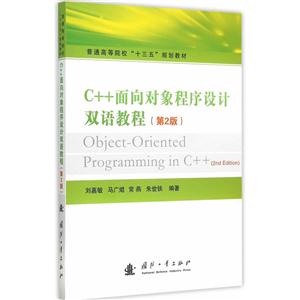-
>
决战行测5000题(言语理解与表达)
-
>
软件性能测试.分析与调优实践之路
-
>
第一行代码Android
-
>
深度学习
-
>
Unreal Engine 4蓝图完全学习教程
-
>
深入理解计算机系统-原书第3版
-
>
Word/Excel PPT 2013办公应用从入门到精通-(附赠1DVD.含语音视频教学+办公模板+PDF电子书)
C++面向对象程序设计双语教程-(第2版) 版权信息
- ISBN:9787118103656
- 条形码:9787118103656 ; 978-7-118-10365-6
- 装帧:一般胶版纸
- 册数:暂无
- 重量:暂无
- 所属分类:>>
C++面向对象程序设计双语教程-(第2版) 本书特色
由刘嘉敏、马广焜、常燕、朱世铁编著的《c++ 面向对象程序设计双语教程(第2版普通高等院校十三五规划教材)》从面向对象程序设计的特点出发,分章节循序渐进地介绍了面向对象的相关概念及运用c ++实现的过程,并辅以大量程序清单。同时书中在各个章节起始处明确了章节学习目标,且在全书中重要知识点处均有提示,各章末尾有本章出现的重要的词汇注解和本章相应的练习题,有助于读者理解书中内容,帮助读者掌握面向对象编程方法。全书共分8章, 具体内容包括:导论、基本工具、类和对象(1)、类和对象(2)、运算符重载、继承、多态性和虚函数、模板。
C++面向对象程序设计双语教程-(第2版) 内容简介
本书从面向对象程序设计的特点出发,分章节循序渐进地介绍了面向对象的相关概念及运用C++实现的过程,并辅以大量程序清单。同时书中在各个章节起始处明确了章节学习目标,且在全书中重要知识点处均有提示,各章末尾有本章出现的重要的词汇注解和本章相应的练习题,有助于读者理解书中内容,帮助读者掌握面向对象编程方法。 全书共分8章,具体内容包括:导论、基本工具、类和对象(1)、类和对象(2)、运算符重载、继承、多态性和虚函数、模板。
C++面向对象程序设计双语教程-(第2版) 目录
- >
龙榆生:词曲概论/大家小书
龙榆生:词曲概论/大家小书
¥13.0¥24.0 - >
中国人在乌苏里边疆区:历史与人类学概述
中国人在乌苏里边疆区:历史与人类学概述
¥34.1¥48.0 - >
罗庸西南联大授课录
罗庸西南联大授课录
¥13.8¥32.0 - >
二体千字文
二体千字文
¥22.4¥40.0 - >
人文阅读与收藏·良友文学丛书:一天的工作
人文阅读与收藏·良友文学丛书:一天的工作
¥14.7¥45.8 - >
李白与唐代文化
李白与唐代文化
¥8.9¥29.8 - >
伯纳黛特,你要去哪(2021新版)
伯纳黛特,你要去哪(2021新版)
¥15.9¥49.8 - >
经典常谈
经典常谈
¥12.7¥39.8
-
C专家编程
¥41¥69 -
4.23文创礼盒A款--“作家言我精神状态”
¥42.3¥206 -
4.23文创礼盒B款--“作家言我精神状态”
¥42.3¥206 -
一句顶一万句 (印签版)
¥40.4¥68 -
百年书评史散论
¥14.9¥38 -
1980年代:小说六记
¥52.8¥69





















